Margaret Island, a pedestrianized recreational island in the middle of the Danube river, has long been a welcoming green oasis in the heart of Budapest. The island is very popular with residents, especially during weekends.
History
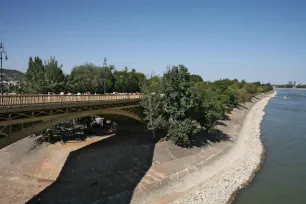
Budapest’s Margaret Island was originally known as Rabbits’ Island. In the Middle Ages, it was home to a number of religious cloisters, the remains of which can still be seen today. At the time, it was only accessible by boat.
By the beginning of the 1800s, when it was known as Palatinus, this 2.5-kilometer-long (1.4 mile) island was embraced by members of the royal family, who built a summer residence here and took it upon themselves to turn it into an ornate garden. The island opened to the public in 1869 and soon became a health resort, attracting visitors taking advantage of its therapeutic springs.
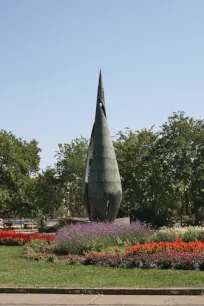
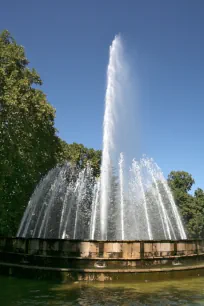
Today, the five-hundred-meter-wide (550 yard) island covers about 92 hectares (227 acres) and is linked to the mainland by two bridges: the Margaret Bridge to the south and the Árpád Bridge in the north. The island is popular for its recreational attractions, but there are also several historical sights on Margitsziget.
Sights & Attractions
Centennial Monument
Entering the island from the Margaret Bridge will put the visitor face-to-face with the Centenary Monument (Centenáriumi emlékmű), created in 1972 and erected the following year to commemorate the 100-year-anniversary of the joining of Buda and Pest in 1873. The bronze monument, designed by István Kiss, resembles two intertwining leafs.
Margitsziget Fountain
Not far from the monument is a large fountain animated with background music. The fountain’s central jet propels water up to a height of twenty-five meters. At night the fountain is beautifully illuminated.
Olympic Pool and Palatinus-strand
Nearby, on the west side of the island, is a swimming pool complex named after Hájos Alfréd, winner of two swimming medals at the 1896 Olympics in Athens. The complex includes an outdoor fifty-meter pool which is open year-round.
About one kilometer further up north is another swimming venue, the Palatinus Strand, a huge complex with several open-air pools, all with different temperatures. There are also wave baths, water slides and there’s even an area for nudists.
Franciscan and Dominican Ruins
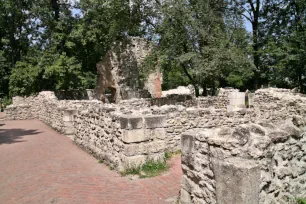
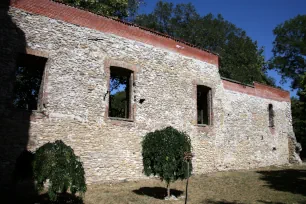
Between the two swimming complexes, towards the east, you’ll find the ruins of a Franciscan church from 1272. The Gothic church was part of a cloister, of which only a wall remains.
More to the north are the ruins of a former convent once home to princess Margit, the daughter of King Béla IV, for whom the island was named. In 1241 King Béla IV vowed to put his daughter in a convent if he succeeded in repelling the Mongol invasion. He kept his word and built a Dominican convent where, in 1251, he sent his nine-year-old daughter. She died here at the young age of twenty-nine years.
Both cloisters were destroyed by the Turks in the sixteenth century. The ruins were excavated in the nineteenth and twentieth centuries. During the excavations, the body of Margit was found and exhumed.
Premonstratensian Chapel
Another ecclesiastical building, the Romanesque chapel of the medieval Premonstratensian monastery, stands nearby the ruins of the Dominican convent. Its history goes back to the eleventh century. The chapel was destroyed in 1541 during the Turkish invasion, but rebuilt in the 1930s using material from the original structure. Its tower bell, which was buried before the invasion was discovered in the early twentieth century, dates from the fifteenth century.
Artists’ Promenade
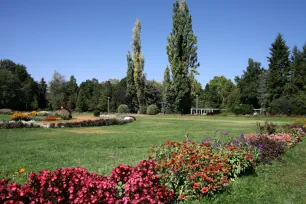
Just north of the former Dominican convent is the Artists’ Promenade (Művész-sétány), flanked with busts honoring Hungarian writers, artists and musicians.
Flower Garden
A beautiful flower garden occupies the center of Margaret Island. The garden has a geometrical layout and is planted with a colorful assortment of flowers from a wide variety of species. At the edge of the garden are a couple of enclosures with waterfowl, deer and some other animals.
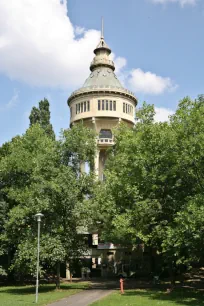
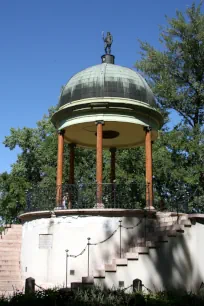
Water Tower and Open-air Theater
The 57-meter-tall (187 feet) octagonal Water Tower (Víztorony), situated north of the flower garden, towers over Margitsziget and is visible from afar. The elegant Art Nouveau tower, built in 1911, is protected as a UNESCO monument. It is used as a watchtower and exhibition area.
The Water Tower overlooks a large open-air theater (Szabadtéri Színpad), with a seating capacity of 3500. The theater plays host to a variety of events during the summer, including operas, concerts and other stage presentations.
Grand Hotel and Hotel Thermal
At the northern end of Margaret Island are two hotels. The oldest, the Grand Hotel Margitsziget, was built in 1873 after a design by one of Hungary’s most famous architects, Miklós Ybl. The more modern looking Danubius Health Spa Resort Margitsziget was built in the 1970s at the site of a spa resort that was damaged during the Second World War. The two hotels share natural thermal baths.
Japanese Garden and Music Well
Adjacent to the two hotels is a delightful Japanese garden with a fishpond, a rock garden and an artificial waterfall.
A bit further, near the northern tip of the island, stands a small pavilion known as the Music Well (Zenélő kút). Built in 1936, it is a replica of the original well that was created in 1820 by Péter Bodor. It is often called Bodor Well in honor of its creator. The well used to play music on the hour. At the same time, the statue of Neptune on top of the pavilion started to circle. Unfortunately, the mechanism was damaged during the Second World War.

